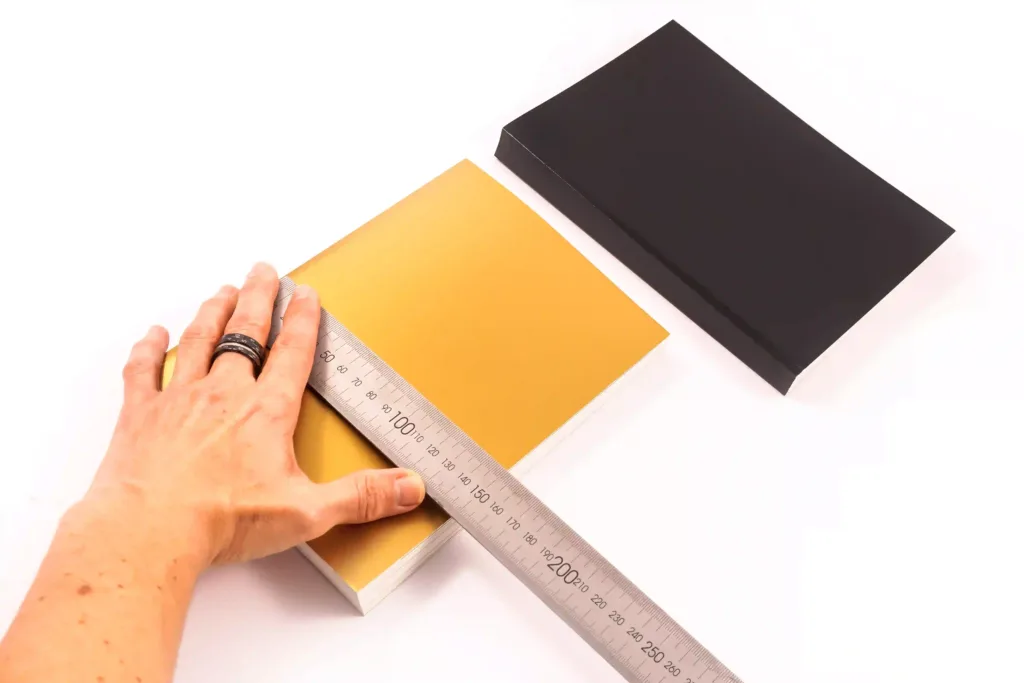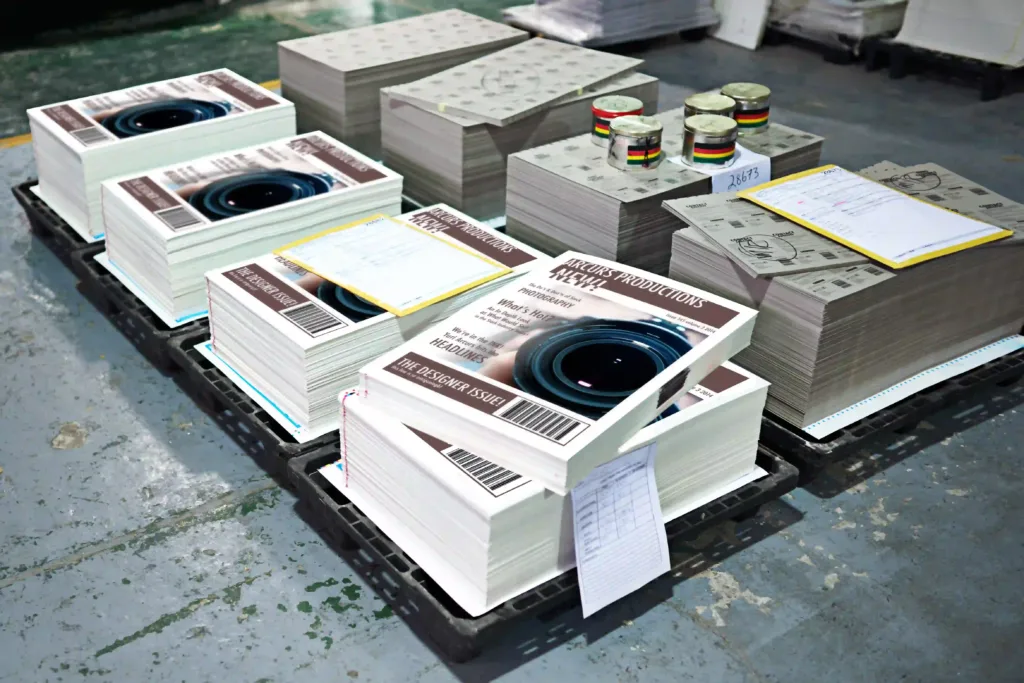Thinking of self-publishing your book? Printing costs can be a mystery, but don’t worry – I’m here to help you navigate the world of book printing like a pro. In this guide, you’ll discover everything you need to know to estimate costs, find the best printing services, and save money without sacrificing quality.
The cost to print a book can range from $4 to $40+ per copy depending on factors like:
- Page count: More pages = higher cost.
- Trim size: Standard sizes (like 5.5×8.5 inches) are usually cheaper.
- Binding type: Paperback is generally more affordable than hardcover.
- Paper type: Thicker, higher-quality paper costs more.
- Printing method: Color printing is more expensive than black and white.
- Print quantity: The more copies you print, the lower the cost per book.
Book printing costs vary wildly, but you CAN control them! Learn how to estimate your expenses, compare printing services, and find ways to save money without sacrificing quality. Dive in and discover how to print your book affordably.
Factors That Influence Book Printing Costs
Alright, let’s dive into the nitty-gritty of what actually goes into calculating those book printing costs. It’s not as simple as just counting the pages (though that’s definitely a big part of it!). Here’s a breakdown of the key factors:
Book Specifications

Think of your book like a delicious cake. You’ve got different layers and ingredients that all contribute to the final flavor… and cost! Here are the “ingredients” that affect your book’s printing price:
- Page Count: This one’s pretty straightforward. The more pages you have, the more paper and ink you’ll need, which directly influences your total printing cost. A 50-page novella will be a lot cheaper to print than a 300-page epic fantasy.
- Trim Size: This refers to the dimensions of your book. Standard sizes like 5.5×8.5 inches or 6×9 inches are usually the most cost-effective. If you’re going for something unusual, like a square book or a super-sized art book, be prepared for a potential price increase.
- Binding Type: Ah, the binding. This is where your book really starts to take shape. You’ve got options like paperback, hardcover, spiral, and saddle-stitch. Each has its own cost implications.

Paperback Binding
- Paperback binding, also known as perfect binding, is the most common choice for, well, paperbacks! It involves gluing the pages together at the spine and wrapping them in a flexible cover. You can even choose different cover finishes, like matte or gloss, to give your book a unique look and feel.
Hardcover Binding
- If you’re looking for durability and a premium feel, hardcover binding (also called case binding) is the way to go. It involves sewing the pages together and encasing them in a sturdy cover made of materials like cloth or printed paper over board. Hardcover books definitely make a statement!
Other Binding Options
- For workbooks, journals, or anything that needs to lay flat, spiral or coil binding is a great choice. And if you’re printing a booklet or magazine, saddle-stitch binding (staples along the spine) might be the most economical option.
- Paper Type: Just like there are different types of cake batter, there are different types of paper!
Interior Paper
- The weight and stock of your paper can affect the look, feel, and cost of your book. GSM (grams per square meter) is the unit used to measure paper weight. Higher GSM means thicker paper. You’ll also have to decide between coated (smooth) or uncoated (more porous) paper. The type of paper you choose will depend on whether you’re printing in black and white or color.
Cover Paper
- For your cover, you’ll want to choose a thicker stock that can withstand wear and tear. You can also add coatings for extra protection and visual appeal.
- Printing Method:
- Do you want your book to be printed in vibrant color or classic black and white? This is a big decision that will significantly impact your printing costs. Color printing is generally more expensive than black and white. You can also save money by choosing double-sided printing.
comparing the cost of black and white vs. color printing:
| Printing Characteristics | Black & White Interior | Color Interior | Additional Notes |
|---|---|---|---|
| Cost per Book (50 pages) | $4.09 – $4.89 | $6.61 – $9.43 | Prices vary by trim size and paper quality |
| Cost per Book (150 pages) | $6.45 – $9.26 | $12.23 – $19.53 | Increase in page count affects cost |
| Cost per Book (300 pages) | $9.87 – $15.63 | $20.17 – $34.86 | Higher page counts significantly increase cost |
| Trim Size Options | 5.5×8.5, 6×9, 8.5×11 | 5.5×8.5, 6×9, 8.5×11 | Same trim sizes available for both options |
| Paper Quality | 60lb white interior stock | 60lb white interior stock | Standard paper quality for both |
| Cover Type | Full color cover with UV Coating | Full color cover with UV Coating | Covers are the same for both types |
| Binding Options | Softcover, Printed Hardcover, Cloth Hardcover, Spiral Bound | Softcover, Printed Hardcover, Cloth Hardcover, Spiral Bound | Binding options consistent regardless of interior color |
| Price Range per Book | $4.09 – $15.63 | $6.61 – $34.86 | Range reflects different quantities and page counts |
| Economic Scale | Lower cost per book with increased quantity | Lower cost per book with increased quantity | Economies of scale apply to both types |
- Print Quantity:
- This is where things get interesting. The more copies you print, the lower the cost per book. It’s all about economies of scale! However, keep in mind that most printing services have minimum print runs, so you’ll need to factor that into your calculations.
It’s tricky to give exact numbers because printing costs vary so much between providers. Below is a table showing how the cost of printing books decreases as the number of books printed increases.
| Binding Style / Quantity | 25 Books | 50 Books | 100 Books | 250 Books | 500 Books | 1,000 Books |
|---|---|---|---|---|---|---|
| Softcover 5.5×8.5 B/W | $5.39 | $4.69 | $4.09 | $3.52 | $3.18 | $2.87 |
| Softcover 5.5×8.5 Color | $8.43 | $7.31 | $6.61 | $5.70 | $4.97 | $4.69 |
| Printed Hardcover 5.5×8.5 B/W | $29.57 | $24.71 | $24.05 | $20.67 | $19.04 | $17.95 |
| Printed Hardcover 5.5×8.5 Color | $33.35 | $27.95 | $26.72 | $22.95 | $20.97 | $19.89 |
| Cloth Hardcover 5.5×8.5 B/W | $43.72 | $37.20 | $39.20 | $33.36 | $30.62 | $28.53 |
| Cloth Hardcover 5.5×8.5 Color | $49.35 | $42.15 | $43.72 | $37.20 | $33.96 | $31.87 |
| Spiral Bound 5.5×8.5 B/W | $6.61 | $5.85 | $5.38 | $4.74 | $4.42 | $4.12 |
| Spiral Bound 5.5×8.5 Color | $9.57 | $8.43 | $7.97 | $6.99 | $6.28 | $5.97 |
Key Takeaways:
- The trend is clear: As you increase the print quantity, the cost per book goes down. This is because the initial setup costs (like creating printing plates) are spread out over more copies.
- Sweet spots exist: There are often price breaks at certain quantity levels (e.g., 100, 250, 500). Printing services may offer discounts at these thresholds.
- Balance is key: While printing in bulk can save money, don’t overestimate your needs. You don’t want to end up with boxes of unsold books!
Important Note: This table is a simplified example. Actual printing costs will vary based on the factors we discussed earlier (paper type, binding, etc.). Always get quotes from multiple printing services to compare prices and find the best deal for your specific needs.
Other Cost Considerations
Don’t forget about these additional costs that can sneak up on you:
- Cover Design: Will you hire a professional designer or create your own cover?
- Interior Formatting and Typesetting: Professional formatting ensures your book looks polished and is easy to read.
- Proofreading and Editing: Catching those typos and grammatical errors is essential!
- ISBN: This unique number identifies your book and is required for selling through most retailers.
Whew! That was a lot to take in. But now you have a much better understanding of the factors that influence book printing costs. Are you ready to explore some printing services?
Comparing Printing Services
Now that you have a good grasp of the factors influencing cost, let’s explore the different types of book printing services available. It’s like choosing a bakery for your cake – each one has its own specialties and price points.
Print-on-Demand (POD) Services

Imagine this: someone orders your book online, and poof—a single copy is printed and shipped directly to them. That’s the magic of print-on-demand (POD). It’s a game-changer for self-published authors, especially those just starting out.
Advantages of POD:
- No upfront inventory costs: You don’t have to pay for a huge print run upfront.
- Ideal for small print runs or backlist titles: Perfect for testing the waters or keeping older books available without storing boxes in your garage.
Disadvantages of POD:
- Higher per-unit cost for large quantities: If you’re planning to sell thousands of books, POD might not be the most economical choice.
Now, let’s take a look at two popular POD services:
Amazon KDP
Amazon KDP (Kindle Direct Publishing) is a go-to for many self-published authors. It’s user-friendly, integrated with the Amazon marketplace, and offers wide distribution.
- Pros:
- Easy to use: Even if you’re tech-challenged, you can navigate KDP with ease.
- Integrated with Amazon: Your book will be available on the largest online bookstore.
- Wide distribution: Reach readers worldwide through Amazon’s extensive network.
- Cons:
- Limited paper and binding options: You might not find the exact specifications you’re looking for.
- Lower royalties for expanded distribution: If you want your book available through bookstores, you’ll earn less per sale.
IngramSpark
IngramSpark is another major player in the POD world. It boasts a wider distribution network and offers more customization options than KDP.
- Pros:
- Wider distribution network: Your book can be ordered by bookstores and libraries worldwide.
- More customization options: You have greater control over paper type, binding, and other specifications.
- Higher royalties: You’ll earn more per sale when your book is ordered through Ingram’s distribution channels.
- Cons:
- More complex setup: IngramSpark can be a bit more challenging to navigate than KDP.
- Higher upfront costs for some services: You might have to pay extra for things like cover design and ISBN assignment.
Offset Printing Services
Offset printing is the traditional method of book printing. It involves creating plates that transfer ink to paper, and it’s the best choice for large print runs.
Advantages of Offset Printing:
- Lower per-unit cost for bulk orders: If you need thousands of copies, offset printing will save you money.
- High-quality printing: Offset printing produces sharp images and vibrant colors.
Disadvantages of Offset Printing:
- Higher upfront costs: You’ll need to pay for the entire print run upfront.
- Requires storage for inventory: You’ll need a place to store all those books!
Online Book Printing Services
In addition to POD and offset printing, there are also several online book printing services that cater to self-published authors. Here are a few popular options:
- Lulu: Lulu is a well-known platform that offers a wide range of printing options and formats.
- Barnes & Noble Press: This service is a good choice if you want your book to be available through Barnes & Noble stores.
- Blurb: Blurb specializes in photo books and offers high-quality printing and binding options.
Tips to Reduce Book Printing Costs
Okay, so you’ve got a good idea of the factors that influence printing costs and the different printing services out there. Now, how can you save some money without compromising on quality? Here are a few tips:
- Print in Bulk: Remember that graph we looked at earlier? The more copies you print, the lower your per-unit cost. If you’re confident in your book’s potential, consider printing a larger quantity upfront. You can always store extra copies and sell them as needed.
- Choose Economical Paper: You don’t have to break the bank to get a beautiful book. There are plenty of cost-effective paper options that still offer excellent quality. Talk to your printing service about their recommendations.
- Simplify Binding: Paperback binding is generally cheaper than hardcover binding. If you’re on a tight budget, consider sticking with a paperback edition. You can always release a hardcover version later if your book takes off!
- Design Your Own Cover: If you’re creatively inclined, why not try designing your own cover? There are plenty of user-friendly online design tools available, like Canva or Adobe Spark. You can also find free stock photos and illustrations to use in your design.
- Explore Free Formatting and Proofreading Resources: Formatting your book correctly can be tricky. Luckily, there are free online tools and resources that can help. You can also ask friends or fellow writers to proofread your manuscript for you.
By following these tips, you can significantly reduce your book printing costs without sacrificing the quality of your book. Every penny counts, right?
Frequently Asked Questions
You’ve got questions, we’ve got answers! Here are some common queries often have about book printing:
- How do I choose the right printing service?
- Ah, the million-dollar question! There’s no one-size-fits-all answer, but here are some factors to consider:
- Your budget: How much are you willing to spend?
- Your print quantity: Are you printing a few copies or thousands?
- Your distribution needs: Do you want your book available in bookstores or just online?
- Your customization preferences: How important are paper type, binding options, and other details?
- Once you have a good understanding of your needs, you can start comparing different printing services and see which one best fits the bill.
- Ah, the million-dollar question! There’s no one-size-fits-all answer, but here are some factors to consider:
- How do I get an ISBN?
- An ISBN (International Standard Book Number) is like your book’s unique ID. You’ll need it to sell your book through most retailers and libraries. You can purchase ISBNs through your country’s ISBN agency. In the US, that’s Bowker Identifier Services.
- How can I ensure the quality of my printed book?
- Quality is key! Here are a few tips to ensure your book looks its best:
- Choose a reputable printing service: Do your research and read reviews before selecting a printer.
- Request a proof copy: Most printing services offer proof copies so you can check the quality before committing to a full print run.
- Provide high-resolution files: Make sure your cover design and interior files are in the correct format and resolution.
- Quality is key! Here are a few tips to ensure your book looks its best:
- What should I do if there are printing errors?
- Ugh, printing errors are the worst! But don’t panic. Most printing services have quality control measures in place and will reprint your book if there are significant errors. Be sure to contact your printing service immediately if you find any problems.
Conclusion
Well, there you have it! We’ve covered a lot of ground in this guide to book printing costs. You’ve learned about the factors that influence pricing, explored different printing services, and even discovered some handy tips for saving money.
Remember, publishing a book is an investment, but it doesn’t have to be a financial burden. By understanding the costs involved and making informed decisions, you can bring your book to life without emptying your wallet.
So, what are you waiting for? Take the next step in your publishing journey and get those pages printed!
Want to explore your options? Get a free book printing quote today!







